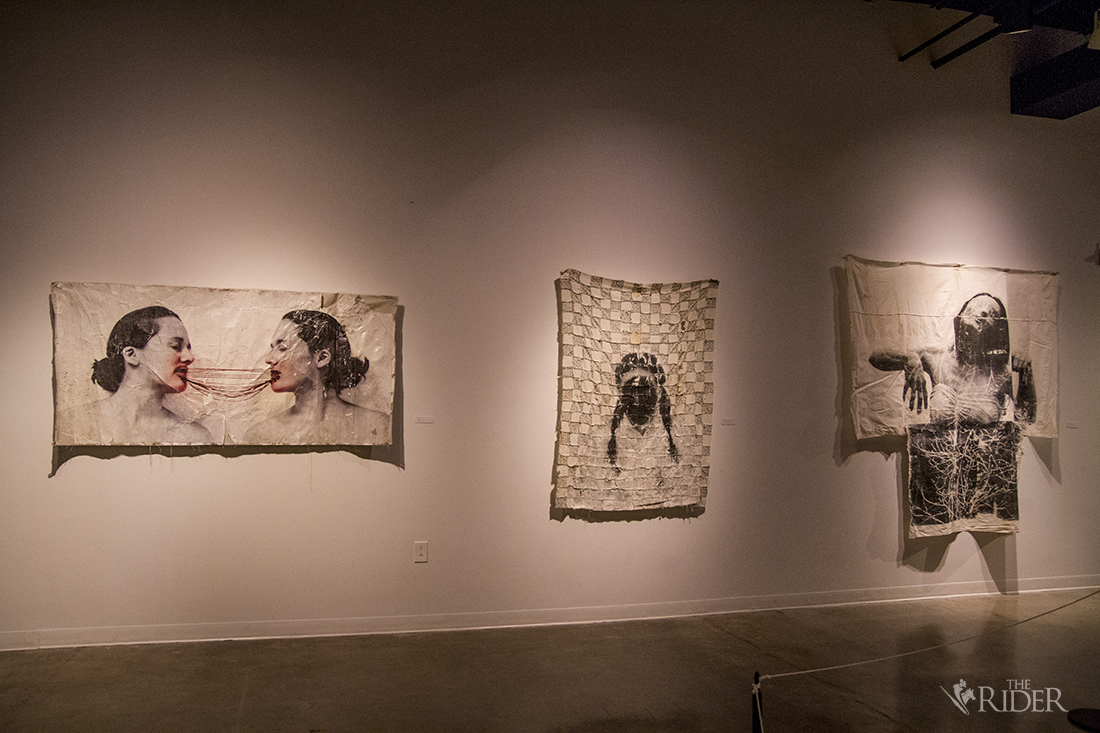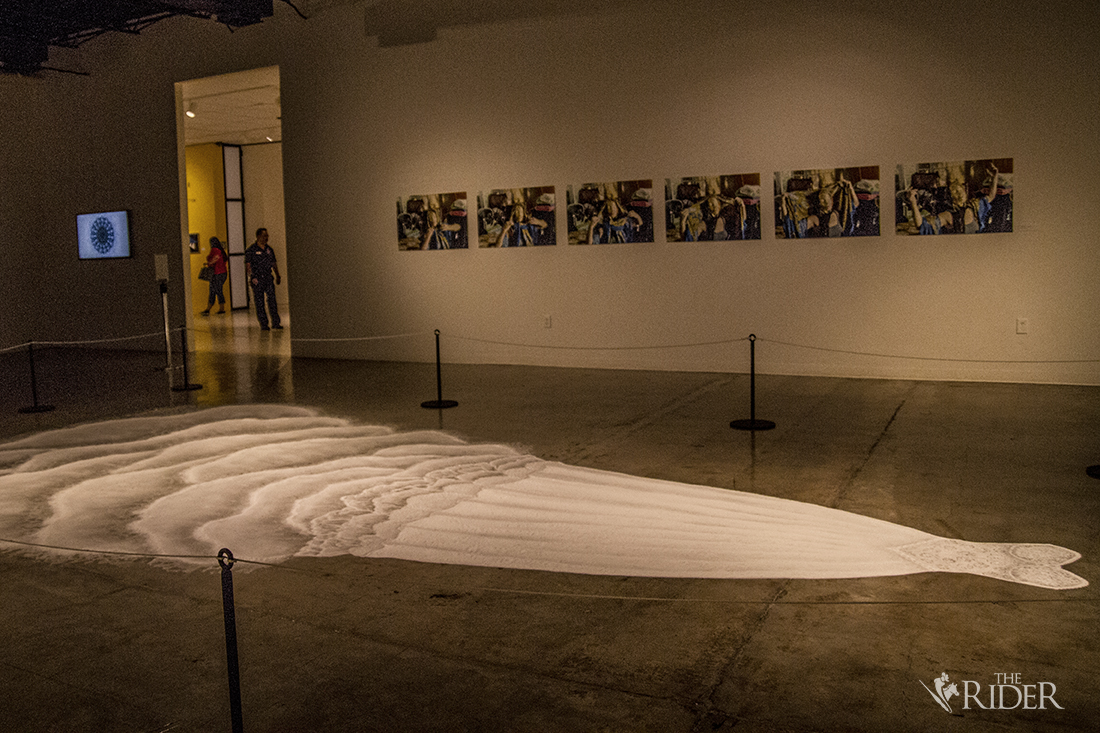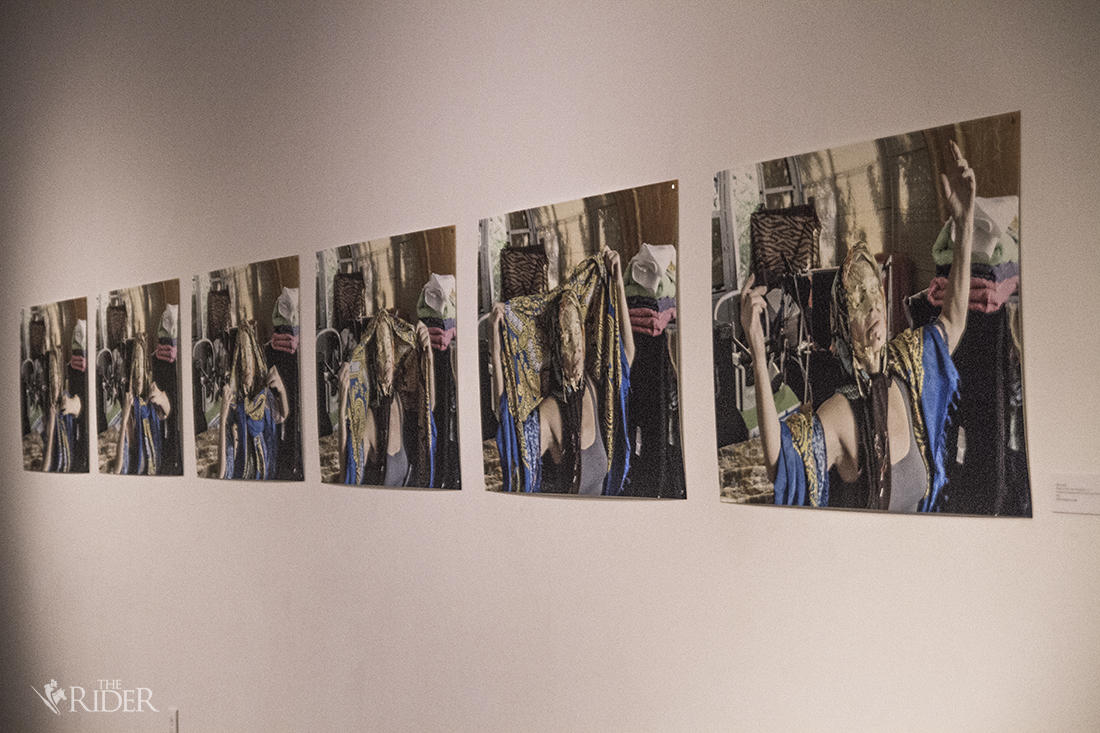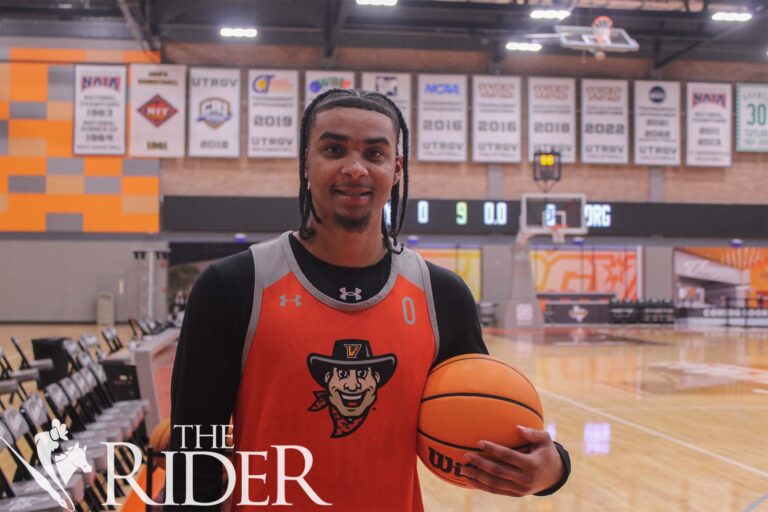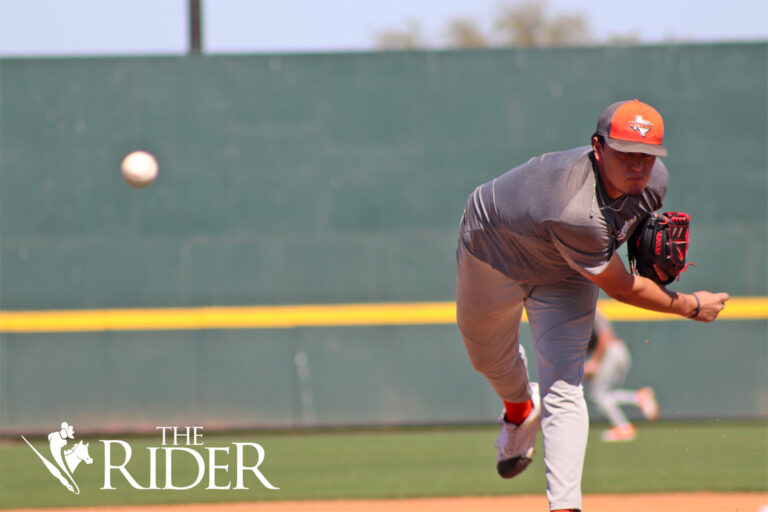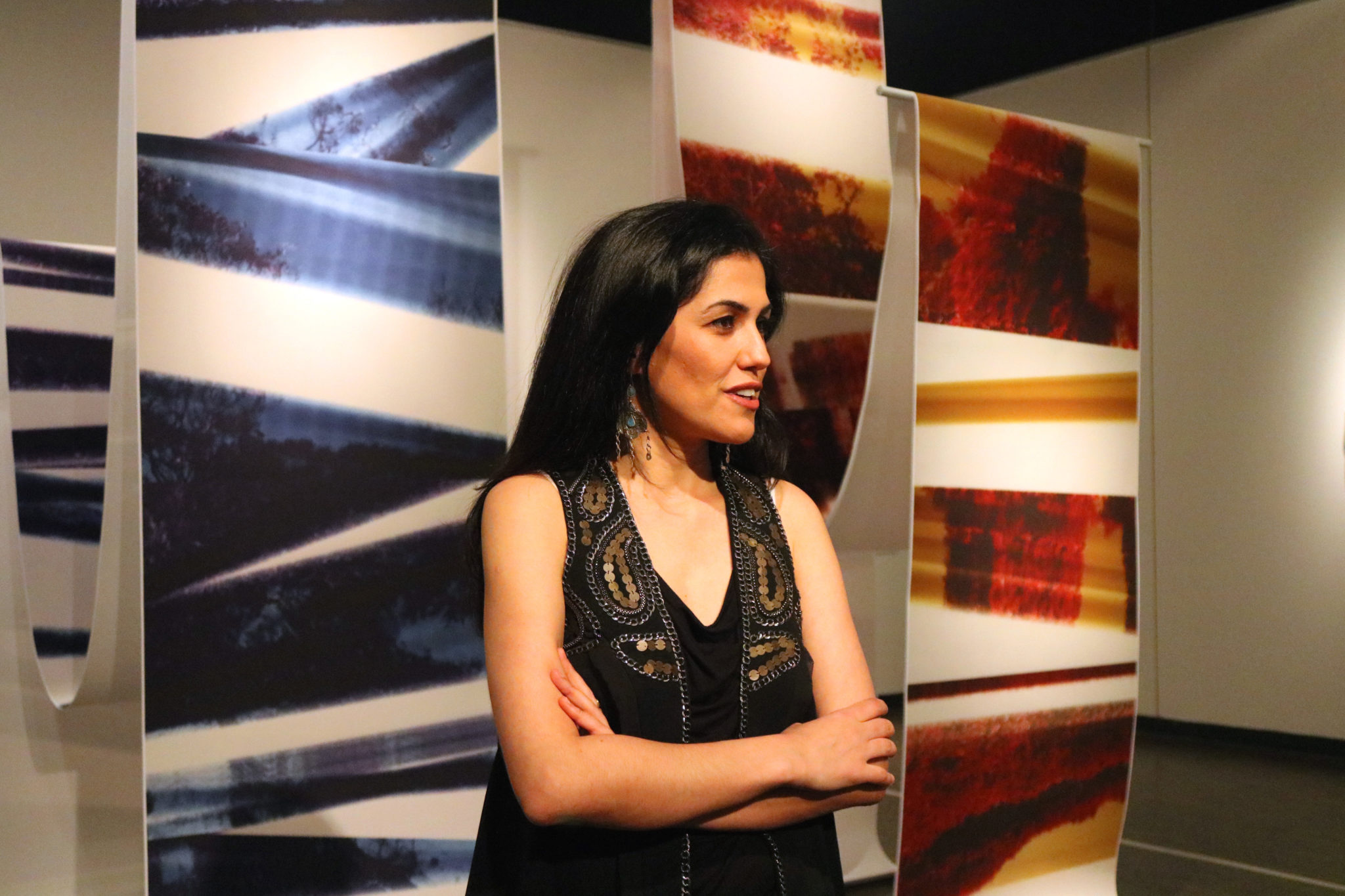
When I traveled to the International Museum of Art & Science to write this story, I got stuck staring at “Ouroboros” by artist Anja Marais, being displayed with the “FOLD” collection.
Taken aback by the powerful image, I was completely engulfed in the artist’s work, letting time and people pass me by completely.
Not soon after realizing I had perhaps been there too long, a man approached me before I could walk away from the piece.
His body language all over the place, and a quick glance at the piece, then to me, he asked me for my interpretation of what it meant.
I looked at it once again and said ever so admiringly, “The repression of women’s voice. Look at her mouth, this openness as if she is screaming to be heard. The blood dripping and duplicated image as if she’s shifting into two people and losing her life simply by talking.”
Laughing at my response, he shrugged his shoulders and said matter-of-factly, “Those darn men, huh?” like if it was the ending joke in a ’70s family sitcom.
He flashed me a smile that curled to his cheeks, quite instantly reminding me of a hungry cougar I once saw from my binoculars in the mountains of Yosemite as a young girl.
The admiration vanished from my face, and what replaced it was a look that if could kill, would’ve robbed this cat of his life.
Scurrying away from me once noting I was in no mood for his antics, I was left alone again with “Ouroboros.”
Looking at it this time, I couldn’t help but think of myself, and all the women before me, who had to scream until blood came out of their mouth in order to be heard over the ignorance and obstacles that stood in their way.
“FOLD,” a bold endeavor curated by Raheleh Filsoofi, a multidisciplinary artist and assistant professor, features 13 female artists and lectures from seven UTRGV scholars. The exhibit is part of this year’s Festival of International Books & Arts (FESTIBA).
The events are spread out in multiple locations and galleries, making it one of the biggest exhibitions the Rio Grande Valley art scene has seen.
Discussing the exhibition and feminism, Filsoofi took time to chat with The Rider and elaborate on the inspiration behind her work.
Q: What inspired this collection?
A: “The inspiration comes from the book called “FOLD,” which is by a French philosopher, Deleuze. I read that book in 2016. I had some discussions with friends and my mentor, and I, because I am an artist myself, wanted to see how it’s related to my work. Deleuze talks about complexity in the universe, and he had a lot of questions, and he gave reference to another philosopher from the 18th century. To me, it was interesting that one philosopher takes the idea of another philosopher, that idea travels through time, gets developed, and then it gets to somebody like us, artists, who work without coming just with a theory. We make artwork, which is a tangible way of approaching issues. … Most philosophers were questioned of not including women in their studies, or not addressing women’s issues, so it was interesting for me to bring all these female faculty and female artists together for this expanded conversation, and also to show the contribution of women scholars, women artists and women intellectuals.”
Q: What was the process like setting up the exhibits and talks?
A: “Coordinating with everyone for a specific time has been very challenging, but most of my artists and scholars were very cooperative. They loved to be part of this project, so they made the time. This is how it somehow works. Organizing it has been a challenge.”
Q: Do you have a particular favorite piece?
A: “It’s hard to choose! You know, all the artworks are unique. I look at one of them and think, ‘Oh my God, this is my favorite,’ then I look at another one and think, ‘Oh, maybe that’s my favorite.’ They’re all powerful and they have their own stories.
Q: What were some challenges you faced in the process, and how did you overcome them?
A: “Most of my artists live outside of the States, or even different countries. So, I always had kind of an appointment with them, talk to them one on one. I actually went to some of their studios. I traveled and looked at their artwork in their studio and I selected them. So, that happened in the course of 15 months. … Then with the scholars, most of them are from UTRGV, so we met three times during the academic year, and they all made that time. Yes, it was a little bit hard for some people, that they were struggling or they had some other obligations, but we made it happen. So, it worked.”
Q: What do you think are the strengths of this exhibit in its entirety?
A: “I see a lot of strengths, not that it’s because it’s my work, because honestly, I just brought everybody together. This is the work and contribution of a lot of people. This is the work of many individual scholars and intellectuals. We have two of our scholars that are men. We invited them to join and they loved it, but the majority of our participants are women, and for me, the strengths of it come from the location that we are in. I came to the Rio Grande Valley two years ago, and I didn’t see a vibrant art community. … And here to me, there is a nice community, but they need to push the limit, and we were hoping that this was going to inspire the new generation of the artists that are living in the Valley. I have a lot of female students that don’t know what they can do with their art, and such a great impact they can have on their community. This is mostly for my students. Some of them have never traveled outside of the Valley, and we were hoping to bring whatever other women artists are doing somewhere else, to bring it to them, for them to get inspired and hopefully, their work is going to travel on the other side of the world.”
Q: What message do you hope the collection sends to locals and visitors?
A: “It is something we give to our community as an artist and a scholar. We want them to get engaged. We want them to come and support, and see the artwork, ask questions. We want to raise curiosity in our community. We live in a very specific place in time, politically. We are experiencing a lot of issues regarding women, especially this region when it comes to the border issue. We need to bring more attention to this area. All of these things, I’m hoping this opens a door for other people to find a way, if they have something to say, to say it without being afraid. … We got a lot of good feedback, but we also received a lot of negative impact. Some people were saying we’re a bunch of feminists, using art as a ‘specific agenda.’ They do not realize that we just need to be heard. There are stories that all these artists and scholars have. Something brings them together. We have a scholar who talks about domestic abuse and violence against women. We have another artist, who is one of my painters, beautiful installation, it’s a beautiful painting, but she is feeling the anger of how she was sexually abused. These are the issues that all the women are dealing with, and so many people do not want to talk about it. We have two different ways of communicating this. This is not about, I mean, I want to be known as a feminist scholar and artist myself, because this is something needed. I am a woman and I know women’s issues. Rejecting feminism, and rejecting advocating women’s issues, is the biggest issue of all time. This is a right. Some people do not understand that. This is a shame. That’s why I invite them to come read the statement, listen to the scholars carefully, before judging them, judging us a group of women who are trying to do something important for other women.”
Q: What is art to you?
A: “That’s a hard question because I’ve dedicated my life to my practice for over 20 years. So, because of my artwork, I compromise my time for my family. Art is my life. It is an essential part to who I am. Art is something that connects everything to me, like, I can’t separate myself. It’s everything for me in my life. That’s why I’ve dedicated my life to it. This is one of the reasons I teach. It’s because I am an artist. I believe in how art is part of the education.”
Q: Do you have any advice for student artists?
A: “If you want to become an artist, you need to have dedication and commitment. You cannot be a good artist if you cannot go all the way. You need a lot of compromise. I believe there are two professions that they need to put their professions first, doctors and artists. Personal life sometimes doesn’t have any meaning, because you make a commitment to people’s health and mind, to the practice of who we are as humans. If you want to be a good artist, you have to dedicate yourself entirely to what you do. And you have to believe in it. If you don’t believe in it, nothing is going to come out of it.”
“FOLD” exhibitions are located at the IMAS in McAllen, the Visual Arts Gallery in the Visual Arts Annex in Edinburg, with the third exhibition opening Tuesday in the Visitors Center on the Edinburg campus. At 5 p.m. Tuesday, panel discussions on immigrant identities, sexual victimization, feminism and “FOLD,” and unfolding the UTRGV students will be conducted in the Visitors Center.


